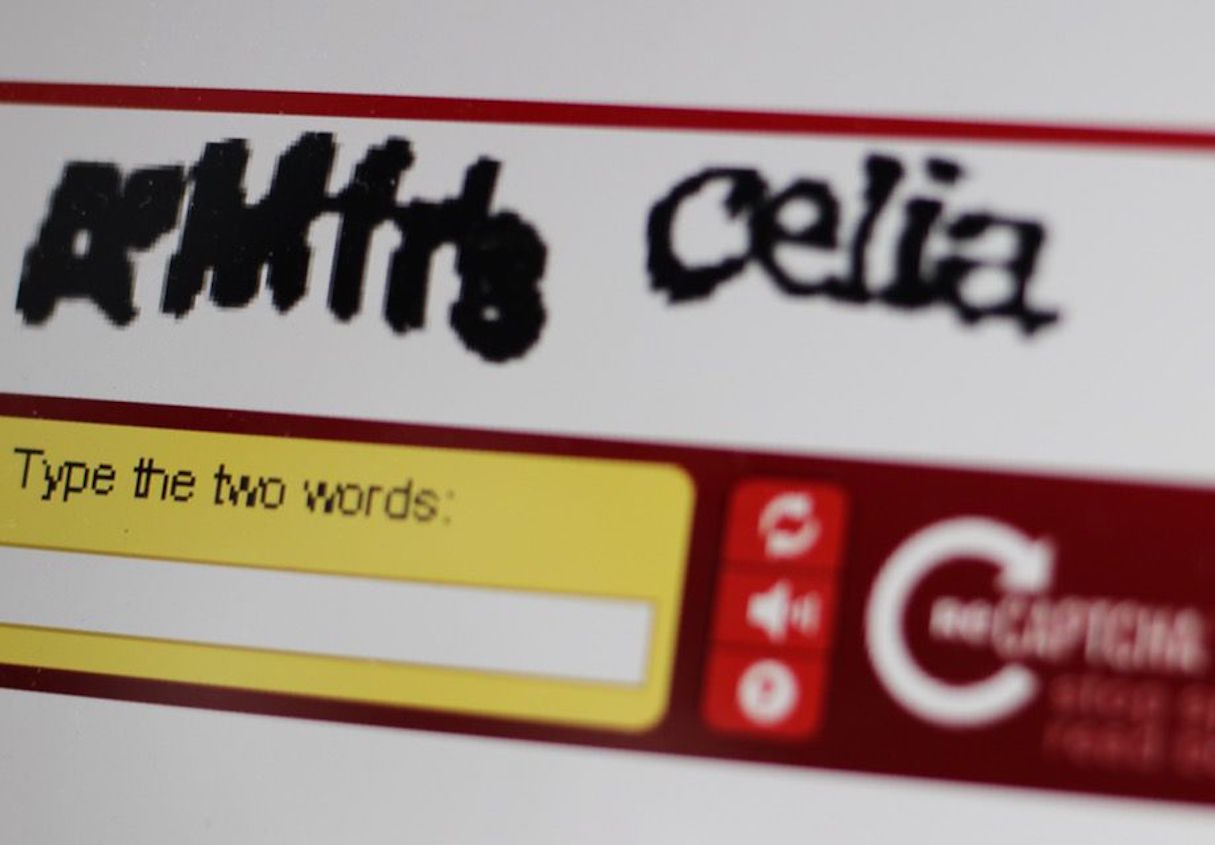If you want a competitive advantage, nothing is better than offering a great experience to your customers. But then, you know that if you are reading this blog post.
Are you doing all you can to create a great experience, or are you just paying lip service to it? Below, I share with you the seven deadly sins of user experience design.
I hope you’re a saint and not a sinner.
You might also like: Forget User Experience. Start Thinking About Client Experience.
1. Sloth: Making it the user’s problem
Doing the right thing by your users can be hard work sometimes. When deadlines are tight, and you are under pressure from above, it can be easier to roll over and make it the user’s problem.
Take CAPTCHA for example. Preventing spam without resorting to CAPTCHA is hard work. Instead of coding spam filters or honey traps, we just slap on a CAPTCHA field and make it the user’s problem.
 CAPTCHA perfectly captures our slovenly behaviour.
CAPTCHA perfectly captures our slovenly behaviour.
But it is not just CAPTCHA. From poor performance to excessive password settings, we are always ready to shift our problems onto the user. But we need to be better than that.
We can combat our inner sloth with continual vigilance. By monitoring our analytics and user behaviour, we see how our shortcuts cost us in the end.
How a CAPTCHA form leads to drop-offs in form completions. How excessive password requirements result in forgotten password requests. When we can see the consequences of our actions, we are more willing to change our ways.
2. Envy: Copying the competition
Then there is envy. Looking at the sites of competitors, or even big players like Amazon, and thinking we want to be like them.
We long after their success and think emulating them is the answer. But copying the competition is not the answer. We are not our competition, and our envy can damage the user experience. Our users want a tailored experience, not a cheap knock off.
 Just because you have an ecommerce site does not mean you can blindly copy Amazon.
Just because you have an ecommerce site does not mean you can blindly copy Amazon.
What works for Amazon will not work for you. You don’t have the scale of Amazon. You don’t have the same breadth of products as Amazon. You’re also not your competition. You are unique, and envy will lead to user experience damnation.
It is time for us to stop looking at our competition for inspiration. If you do that, you will always be a follower. Instead we need to look beyond our sector for inspiration.
If you run an ecommerce site try looking at how charities persuade users to act or even a good kickstarter campaign. Only if we start doing that will we innovate and forge the best path forward.
3. Lust: Obsessing over the visuals
Our envy of the competition can take another sinful turn. We can lust over their designs, their branding, their aesthetics. If not them, then we look to design leaders like Apple and drool.
Appreciating good design is one thing. But we lust after it and want it. We start copying and stealing it. But by doing so we corrupt it. What we produce is never as good as the original. We try to emulate and we fail.
 In our desire to make sites with the 'wow factor' we often compromise the user experience.
In our desire to make sites with the 'wow factor' we often compromise the user experience.
But worst of all, our lust for gorgeous design means we start to overlook usability and accessibility. We focus on flashy graphics, rather than meeting the needs of users. We clutter our designs with so much eye candy that it is distracting and damages performance. In the end our desire to impress, alienates.
To overcome the temptation to lust, do not start with aesthetics. Begin your journey with usability and accessibility. Build prototypes and wireframes that have little in the way of aesthetics. Get them right through iterative rounds of testing, and only then start to add aesthetics into the equation.
Finally, if time and budget allows, add those design delighters that give the wow factor. But these should be the icing on the cake. After all, nobody enjoys a cake that is all icing.
4. Greed: Tricking users into action
It is easy to become too greedy when running an ecommerce site. Greedy for another sale, another conversion. Greed to up-sell and increase the average order value.
The result is that we resort to trickery to gain conversions. Adding items to basket without asking, pushing annoying overlays in people’s faces. Checking checkboxes by default. Hidden delivery costs. Anything to land one more lead, one more sale.
 As a desperate attempt to generate more revenue some sites resort to adding items to user carts without permission.
As a desperate attempt to generate more revenue some sites resort to adding items to user carts without permission.
This works in the short term. But the fallout is huge. Our greed alienates and angers users. They feel we just see them as a cash cow, rather than a valued customer. It is a dangerous road to go down.
The problem is that anger is often unseen. We don’t realise how much these kinds of tactics irritate users. That is why usability testing is so important. Our greed will wilt in the face of a user ranting about checkboxes or angry about hidden delivery charges. We will realise just how much damage we are doing. But, if we never sit down opposite a user and see their frustration we will justify our greed as good business practice.
5. Gluttony: Becoming a data pig
We don’t just want a customer's money, we want their data too. We gorge ourselves on those demographics. We use them to create ever more targeted and manipulative sales promotions.
We become hungry for ever more information. We ask users for all kinds of information we do not need to fulfil their order. We have required fields for telephone numbers, how they found us, and social media. Anything to build a better picture of them so we can target them.
 We become obsessed with gathering data on our users.
We become obsessed with gathering data on our users.
This wouldn’t be terrible if we were using that data to help the user. But if we are honest, that is not our motivation. We seek only to sell to them. We have become gluttons for their data.
Watching a user attempt to fill out a form on a mobile device is enough to make anybody think twice about adding yet more fields. We need to be challenging every field we add to a form. Every piece of information we ask from a user.
Too often, user experience designers have to argue to keep fields from creeping in. That should be the other way around. If somebody wants to ask a user for any information, they need to be able to explain to the user why they need that information. Justify every field added.
6. Pride: The ‘we know best’ mentality
But the biggest sin of user experience design is pride. Priding ourselves as experts in our field. Priding ourselves that we know best. This pride can manifest itself in two ways.
First, we see ourselves as the owner of user experience. That nobody else can contribute to the creation of a better user experience. We ignore the vital role that developers, copywriters, marketers, and many others have.
Thinking we have all the answers as UX designers is arrogant, and failing to test our designs with users is just negligent.
Second, our pride leads us to ignore our users. We feel we don’t need to run usability testing. After all, we reason, we have been designing sites for years. We know what works and what doesn’t.
Our pride really does lead to a fall, as users abandon us for the competition and we see our sales plummet. All because we were too proud to listen to our colleagues and users.
Yet this is avoidable. Make a decision here and now. Before you undertake any more projects. Promise yourself that every project you undertake will begin with a discovery phase. A chance to speak to users and other stakeholders.
Tell yourself that no matter how well briefed you think you are you will carry out a discovery phase. That no matter how tight the timescales or small the budgets, you will spend at least some time talking to others.
By making it a non-negotiable part of your process it will prevent you from falling into temptation. I promise that the time will be recovered as you avoid bad decisions further down the road.
7. Wrath: Disappointing after sales
Finally, we come to wrath. When it comes to wrath, we take a different turn. It is not us exhibiting wrath, but us creating those feelings in our users.
Our other deadly sins combine to undermine the experience and create anger. Nowhere is this more evident than after sales.
 Our behavior does nothing but anger and frustrate our users.
Our behavior does nothing but anger and frustrate our users.
We trick users into buying, and hide delivery costs. We focus on profitability and so skimp on after sales. We abandon them once they have bought, apart from the endless emails asking them to buy again. Emails we tricked them into agreeing to receive with a pre-checked checkbox.
It is not surprising then, that we drive them to anger.
But do not despair. If you follow the advice in this post you can avoid this road to user experience damnation. Usability testing, user research, discovery phases, and a user experience first approach, can protect you. They can ensure that your users do not leave angry.
It is not too late
It is not too late, dear sinner. Salvation can be yours if you repent your evil ways. In fact, if you stop focusing on the deadly sins and instead focus on the user's needs, you will have your heart's desire. You will have more loyal customers, increased revenue, and less customer support queries.
You might also like: The User Experience Delusion.
Read more
- Streamline Your Ecommerce Experience With The Laws of Simplicity
- 5 Common Digital Content Problems and How to Avoid Them
- Building a VR Shopping Experience for the Web: Tips and Takeaways
- Content Strategy: The Principles we Followed to Build the New Shopify App CLI
- 22 Basic UX Laws That Every Designer Should Know
- UX Designers: Are You Focusing Too Heavily on Creating a Beautiful UI?
- Human-Centered Design: An Introduction, Practices, and Principles
- 3 Strategies for Improving User Experience in Your Ecommerce Designs
- Is Your Mental Model a Confusing Mess to Users?

